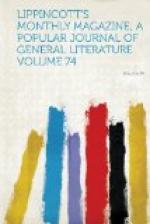During all this week there had been a dead-lock in business in Wall street, although a crowd of persons not belonging to the Exchange gathered on Broad street daily to buy or sell stocks for cash on delivery, the sellers forced by their necessities, and the buyers eager to secure stocks at lower prices than had been known for years. But there were so few persons provided with “the sinews of war” that the aggregate of transactions was small. The usual weekly bank statement was again omitted by the Clearing-house from motives of policy, but it transpired that the whole of the New York associated banks held on the morning of the 27th only twelve millions two hundred thousand of greenbacks, an aggregate still further reduced, at one time, to a point below ten millions, against nearly thirty-five millions—bank average—on the 20th, the date of the last statement issued. Their determination to sustain each other was, however, so strong that it tended to inspire confidence in their ability to weather the storm. It was also made known that they had agreed, on the resumption of business by the Stock Exchange, not to certify cheques except against actual balances while any certificates of their own issue remained outstanding. Twenty millions of these had been issued up to this time, and the additional ten millions before referred to were ordered to be issued in like manner, as required. The Treasury paid out during that week, including the previous Saturday, in New York and elsewhere, about thirty-five millions of greenbacks—namely, twenty-two millions in exchange for $5000 and $10,000 certificates of




